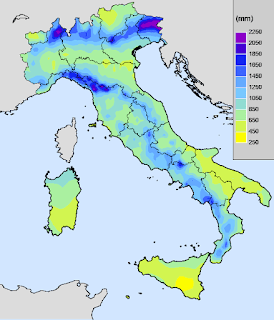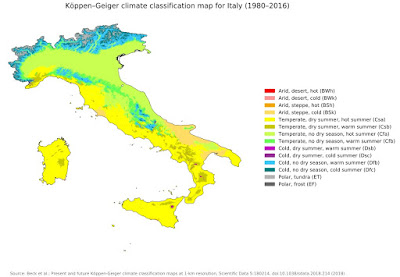For property buyers in Italy the climate often plays an important role. People are mainly looking for a holiday home, that they usually also want to rent out. Moreover, you may have traveled in a specific region of Italy in the summer, probably with nice summer weather. But is it also a nice region to live in in the other seasons? Some regions have notable internal differences, especially where there are mountains. Italy House Hunting cares about informing you about climate differences in Italy before you buy.
 |
| Sunshine in Italy (in hrs per year) |
 |
| Precipitation in Italy (mm/year) |
|
Region |
City |
Alt. (m) |
Tmax Jan. (°C) |
Tmin Jan. (°C) |
Tmax July (°C) |
Tmin July (°C) |
rainfall (mm/yr) |
rain days /yr |
heat days /yr |
frost nights /yr |
fog days /yr |
sun-shine hrs/yr |
avg. sun-shine hrs/day |
|
Abruzzo |
Pescara |
11 |
11 |
2 |
29 |
17 |
657 |
73 |
29 |
27 |
25 |
2.227 |
6,1 |
|
Basilicata |
Picerno |
721 |
6 |
1 |
27 |
16 |
652 |
90 |
N/A |
N/A |
N/A |
2.117 |
5,8 |
|
Calabria |
Isola di Capo Rizzuto |
161 |
13 |
6 |
31 |
19 |
792 |
63 |
46 |
2 |
9 |
2.446 |
6,7 |
|
Calabria |
Reggio Calabria |
21 |
15 |
8 |
31 |
22 |
547 |
69 |
57 |
0 |
0 |
2.482 |
6,8 |
|
Campania |
Napoli |
72 |
13 |
4 |
30 |
19 |
1.008 |
86 |
41 |
9 |
13 |
2.373 |
6,5 |
|
Campania |
Capo Palinuro |
185 |
13 |
8 |
28 |
21 |
730 |
79 |
18 |
0 |
1 |
2.555 |
7,0 |
|
Emilia-Romagna |
Bologna |
42 |
6 |
-1 |
30 |
18 |
671 |
74 |
46 |
49 |
70 |
2.044 |
5,6 |
|
Emilia-Romagna |
Piacenza |
50 |
5 |
-2 |
29 |
16 |
721 |
79 |
31 |
73 |
79 |
2.117 |
5,8 |
|
Emilia-Romagna |
Rimini |
13 |
8 |
0 |
28 |
18 |
655 |
77 |
20 |
43 |
57 |
2.044 |
5,6 |
|
Friuli-Venezia Giulia |
Trieste |
2 |
8 |
3 |
28 |
20 |
1.003 |
92 |
15 |
9 |
5 |
2.117 |
5,8 |
|
Lazio |
Santa Marinella |
4 |
13 |
7 |
27 |
21 |
711 |
66 |
3 |
1 |
0 |
2.519 |
6,9 |
|
Lazio |
Roma Ciampino |
129 |
12 |
3 |
31 |
19 |
793 |
79 |
52 |
19 |
14 |
2.592 |
7,1 |
|
Liguria |
Genova |
3 |
11 |
5 |
27 |
21 |
1.079 |
77 |
9 |
3 |
0 |
2.227 |
6,1 |
|
Liguria |
Capo Mele |
221 |
12 |
7 |
27 |
20 |
716 |
60 |
9 |
1 |
12 |
2.300 |
6,3 |
|
Lombardia |
Bergamo |
237 |
7 |
-1 |
29 |
18 |
1.103 |
90 |
22 |
61 |
48 |
1.825 |
5,0 |
|
Lombardia |
Milano |
122 |
5 |
1 |
29 |
20 |
895 |
81 |
31 |
57 |
93 |
1.825 |
5,0 |
|
Marche |
Ancona |
10 |
9 |
1 |
28 |
17 |
739 |
83 |
20 |
35 |
36 |
2.227 |
6,1 |
|
Molise |
Campobasso |
807 |
7 |
2 |
26 |
17 |
560 |
82 |
13 |
36 |
31 |
2.117 |
5,8 |
|
Piemonte |
Torino |
287 |
5 |
-2 |
28 |
17 |
981 |
81 |
16 |
83 |
46 |
1.971 |
5,4 |
|
Puglia |
Brindisi |
10 |
13 |
7 |
29 |
21 |
604 |
64 |
32 |
1 |
20 |
2.592 |
7,1 |
|
Puglia |
Foggia |
60 |
12 |
3 |
32 |
18 |
495 |
86 |
66 |
18 |
32 |
2.446 |
6,7 |
|
Sardegna |
Cagliari |
1 |
14 |
5 |
31 |
20 |
395 |
61 |
60 |
4 |
20 |
2.701 |
7,4 |
|
Sardegna |
Alghero |
23 |
14 |
6 |
29 |
17 |
573 |
65 |
40 |
5 |
44 |
2.592 |
7,1 |
|
Sicilia |
Gela |
33 |
17 |
9 |
26 |
21 |
368 |
45 |
10 |
0 |
3 |
2.665 |
7,3 |
|
Sicilia |
Messina |
51 |
14 |
10 |
30 |
23 |
847 |
87 |
42 |
0 |
0 |
2.482 |
6,8 |
|
Sicilia |
Trapani |
7 |
15 |
8 |
30 |
20 |
496 |
64 |
41 |
0 |
6 |
2.665 |
7,3 |
|
Toscana |
Arezzo |
248 |
9 |
0 |
30 |
14 |
802 |
87 |
42 |
63 |
36 |
1.971 |
5,4 |
|
Toscana |
Firenze |
40 |
11 |
2 |
31 |
18 |
873 |
88 |
61 |
35 |
27 |
2.117 |
5,8 |
|
Toscana |
Grosseto |
7 |
12 |
3 |
30 |
17 |
632 |
71 |
41 |
25 |
12 |
2.373 |
6,5 |
|
Toscana |
Isola d'Elba |
397 |
10 |
5 |
28 |
19 |
679 |
66 |
6 |
7 |
N/A |
2.154 |
5,9 |
|
Toscana |
Pisa |
1 |
11 |
2 |
29 |
17 |
894 |
85 |
35 |
34 |
55 |
2.263 |
6,2 |
|
Trentino-Alto Adige |
Bolzano |
241 |
6 |
-5 |
29 |
16 |
712 |
77 |
33 |
98 |
15 |
1.898 |
5,2 |
|
Umbria |
Perugia |
205 |
8 |
1 |
29 |
16 |
850 |
96 |
41 |
49 |
32 |
2.117 |
5,8 |
|
Veneto |
Venezia |
6 |
7 |
0 |
28 |
18 |
748 |
79 |
16 |
53 |
61 |
2.044 |
5,6 |
|
Veneto |
Verona |
68 |
6 |
-1 |
30 |
19 |
783 |
77 |
46 |
62 |
79 |
2.190 |
6,0 |
|
ITALY |
National average |
- |
7 |
1 |
28 |
16 |
876 |
81 |
27 |
45 |
51 |
2.232 |
6,1 |
